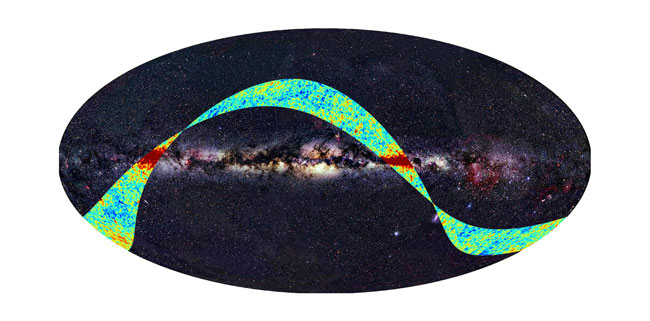Planck Telescope Snaps First Images

The Planck mission has captured its first rough images ofthe sky, as part of its mission to measure light from the dawn of time.
Planck ? a European Space Agency mission with NASAparticipation ? will surveythe entire sky to learn more about the history and evolution of ouruniverse.
The space telescope started surveying the sky regularly onAug. 13 from its vantage point far from Earth. Planck is in orbit around thesecond Lagrange point of our Earth-sun system, a relatively stable spot located930,000 miles (1.5 million kilometers) away from Earth.
"We are beginning to observe ancient light that hastraveled more than 13 billion years to reach us," said Charles Lawrence,the NASA project scientist for the mission at NASA's Jet Propulsion Laboratoryin Pasadena, Calif. "It's tremendously exciting to see these very firstdata from Planck. They show that all systems are working well and give apreview of the all-sky images to come."
Following launch on May 14 (along with its siblingspacecraft Herschel), the satellite's subsystems were checked out inparallel with the cool-down of its instruments' detectors. The detectors arelooking for temperature variations in the cosmic microwave background, whichconsists of microwaves from the early universe. The temperature variations area million times smaller than one degree.
To achieve this precision, Planck's detectors have beencooled to extremelylow temperatures, some of them very close to the lowest temperaturetheoretically attainable.
During the "first-light" survey, which took placefrom Aug. 13 to 27, Planck surveyed the sky continuously. It was carried out toverify the stability of the instruments and the ability to calibrate them overlong periods to the exquisite accuracy needed.
Get the Space.com Newsletter
Breaking space news, the latest updates on rocket launches, skywatching events and more!
The survey yielded maps of a strip of the sky, one for eachof Planck's nine frequencies. Preliminary analysis indicates that the qualityof the data is excellent.
Over the next 15 months, Planck will gather data for twofull independent all-sky maps.
- Video ? The Herschel and Planck Missions
- New European Telescopes to Peer into Obscure Cosmic Corners
- Planck 'Time Machine' to Study Big Bang
Join our Space Forums to keep talking space on the latest missions, night sky and more! And if you have a news tip, correction or comment, let us know at: community@space.com.

Space.com is the premier source of space exploration, innovation and astronomy news, chronicling (and celebrating) humanity's ongoing expansion across the final frontier. Originally founded in 1999, Space.com is, and always has been, the passion of writers and editors who are space fans and also trained journalists. Our current news team consists of Editor-in-Chief Tariq Malik; Editor Hanneke Weitering, Senior Space Writer Mike Wall; Senior Writer Meghan Bartels; Senior Writer Chelsea Gohd, Senior Writer Tereza Pultarova and Staff Writer Alexander Cox, focusing on e-commerce. Senior Producer Steve Spaleta oversees our space videos, with Diana Whitcroft as our Social Media Editor.